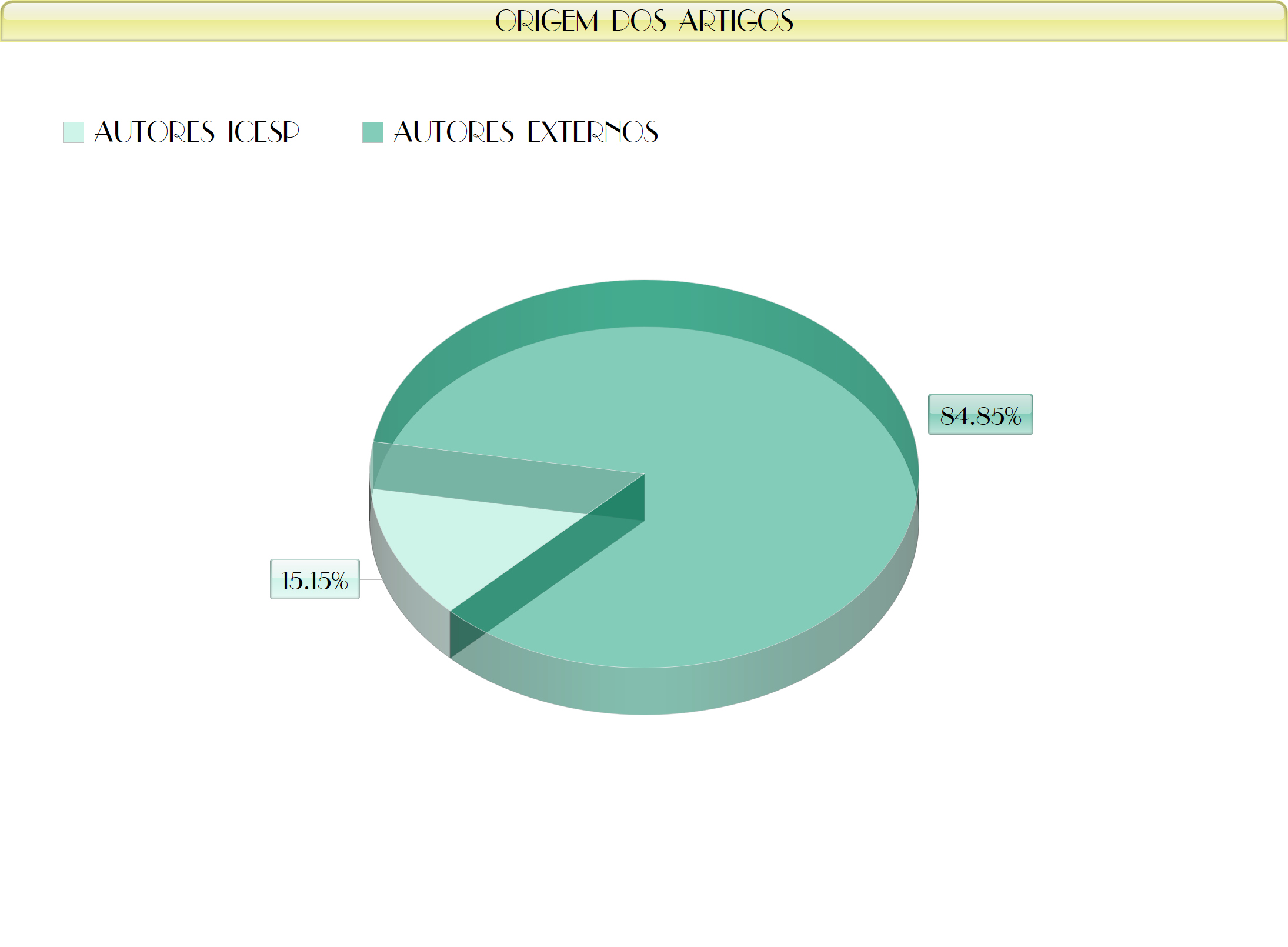A ROTAÇÃO DE OMBRO NÃO AFETA A ATIVAÇÃO MUSCULAR DO PEITORAL MAIOR E DELTOIDE ANTERIOR DURANTE O EXERCÍCIO PEC DECK
Resumo
Resumo
Objetivo: comparar a atividade mioelétrica do peitoral maior (PM) e deltoide anterior (DA) durante o exercício pec deck, em contração voluntária máxima isométrica (CVMI), em rotação interna (RI) e externa (RE) de ombro em diferentes posições articulares. Materiais e Métodos: dez homens saudáveis (idade: 30 ± 6,37 anos, massa corporal total: 84,6 ± 9,43 kg, estatura: 178,6 ± 5,60 cm), treinados em força (tempo de prática: 82,8 ± 63,35 meses), realizaram três CVMI’s durante cinco segundos, e intervalo de 15 segundos entre contrações no exercício pec deck tanto em RI, quanto em RE da articulação do ombro. Um intervalo de 10 minutos foi fornecido aos sujeitos entre condições experimentais em três diferentes posições articulares: máxima adução de ombros (0°), adução dos ombros a 45° e 90°. A atividade mioelétrica do PM e DA foi avaliada por meio de eletromiografia superficial. Resultados: não foram verificadas diferenças significantes entre as rotações de ombro para a ativação muscular em nenhuma das posições articulares analisadas para o DA (0°: d=0,89; Δ%=22,46; 45°: d= 0,65; Δ%=17,95 e 90°: d= 1,26; Δ%=21,16) e para o PM (0°: d= 0,18; Δ%=5,42; 45°: d=0,29; Δ%=10,08 e 90°: d=0,41; Δ%=16,24). Foi verificado aumento significante da ativação muscular do PM em RI na posição de 90° de abdução horizontal de ombro quando comparado a 45° (P<0,05 d=1,85; Δ%=47,00). Conclusão: a realização do exercício pec deck em RI e RE não altera a atividade muscular do PM e do DA, independentemente da posição articular realizada.
Palavras-chave: força; eletromiografia; exercício.
Abstract
Objective: to compare the myoelectric activity of the pectoralis major (PM) and anterior deltoid (AD) during the pec deck exercise, in maximal isometric voluntary contraction (MIVC) in internal rotation (IR) and external (ER) rotation of the shoulder in different joint positions. Methods: ten healthy male (age: 30 ± 6.37 years, total body mass: 84.6 ± 9.43 kg, height: 178.6 ± 5.60 cm), trained in strength (time of practice: 82.8 ± 63.35 months) performed through three MIVC's for five seconds, and a 15-second interval between contractions in the pec deck exercise in both RI and ER of the shoulder joint. A 10-minute interval was provided to subjects between experimental conditions at three different joint positions: maximum shoulder adduction (0°), shoulder adduction at 45° and 90°. The myoelectric activity of the PM and anterior deltoid AD was evaluated by surface electromyography. Results: there were no significant differences between shoulder rotations for muscle activation in any of the joint positions analyzed for the AD (0°: d=0.89; Δ%=22.46; 45°: d= 0.65; Δ%=17.95 e 90°: d= 1.26; Δ%=21.16) and the PM (0°: d= 0.18; Δ%=5.42; 45°: d=0.29; Δ%=10.08 e 90°: d=0.41; Δ%=16.24). There was a significant increase in muscle activation of the PM in IR at the 90° horizontal abduction position of the shoulder when compared to 45° (P<0.05 d=1.85; Δ%=47.00). Conclusion: the performance of the pec deck exercise in IR and RE does not alter the muscular activity of the PM and the AD, independently of the joint position performed.
Keywords: strength; electromyography; exercise.
Figshare DOI: 10.6084/m9.figshare.11195714
Texto completo:
PDFReferências
Marchetti PH, Calheiros R, Charro R. Biomecânica aplicada: uma abordagem para o treinamento de força. São Paulo: Phorte; 2007.
Kolber MJ, Beekhuizen KS, Cheng MS, Hellman MA. Shoulder injuries attributed to resistance training: a brief review. Journal of Strength and Conditioning Research. 2010;24(6):1696–704.
Gross ML, Brenner SL, Esformes I, Sonzogni JJ. Anterior shoulder instability in weight lifters. The American Journal of Sports Medicine. 1993;21(4):529-603.
Bak K, Cameron EA, Henderson IJP. Rupture of the pectoralis major: a meta-analysis of 112 cases. Knee Surg, Sports Traumatol, Arthrosc. 2000;8:113-9.
Yu SJ, Habib PA. Common injuries related to weightlifting: MR imaging perspective. Seminars in musculoskeletal radiology. 2005;9(4):289-301.
Alabbad MA, Muaidi QI. Incidence and prevalence of weight lifting injuries: An update. Saudi Journal of Sports Medicine. 2016;16:15-9.
Siewe J, Marx G, Knoll P, Eysel P, Zarghooni K, Graf M, et al. Injuries and overuse syndromes in competitive and elite bodybuilding. International Journal of Sports Medicine. 2014;35(11):943-8.
Lodhia KR, Brahma B, McGillicuddy JE. Peripheral nerve injuries in weight training. The Physician and Sportsmedicine,. 2005;33(7):24-37.
Marchetti PH, Amorim MA, Arruda CC, Segamarchi LF, Soares EG, Ito DT, et al. Aspectos neuromecânicos do exercício pulley. Revista Brasileira de Ciências da Saúde. 2010;8(26):59-64.
Marchetti PH, Arruda CC, Segamarchi LF, Soares EG, Ito DT, Da Luz Junior DA, et al. Exercício supino: uma breve revisão sobre os aspectos biomecânicos. Brazilian Journal of Sports and Exercise Research. 2010;1(2):135-42.
Giorgio P, Samozino P, Morin JB. Multigrip flexible device: electromyographical analysis and comparison with the bench press exercise. Journal of Strength and Conditioning Research. 2009;23(2):652–9.
Eng J. Sample Size Estimation: How many individuals should be studied? Radiology. 2003;227(2):309-13.
Beck TW. The importance of a priori sample size estimation in strength and conditioning research. Journal of Strength and Conditioning Research. 2013;27(8): 2323-37.
Freitas Junior IF. Padronização de medidas antropométrias e avaliação da composição corporal. Sao Paulo: Tikinet; 2018.
Monteiro GA. Avaliação da Flexibilidade: Manual de Utilização do Flexímetro Sanny2000.
Criswell E. Cram’s Introduction to surface electromyography. 2 ed. Burlington, MA: Jones and Bartlett; 2011.
Hermens HJ, Freriks B, Disselhorst-Klug C, Rau G. Development of recommendations for SEMG sensors and sensor placement procedures. Journal of Electromyography and Kinesiology. 2000 Oct;10(5):361-74.
Winter DA. Biomechanics and motor control of human movement. Publication AWI, editor. USA1990.
Rosner B. Fundamentals of Biostatistics. 7 ed: Cengage Learning; 2010.
Rhea MR. Determining the magnitude of treatment effects in strength training research through the use of the effect size. J Strength Cond Res. 2004 Nov;18(4):918-20.
Brown LE. Treinamento de força. Barueri: Manole; 2008.
Barnett C, Kippers V, Turner P. Effects of variation of the bench press exercise on the EMG activity of five shoulder muscles. Journal of Strength and Conditioning Research. 1995;9(4):222-7.
Durall CJ, Manske RC, Davies GJ. Avoiding shoulder injury from resistance training. Strength and Conditioning Journal. 2001;23(5):10-8.
Sigmon C, Tyson A. Preventing shouder injuries by modifying the bench and incline press. Nat Strength Cond J. 1996:52-3.
Brumitt J, Meira E. Scapula stabilization rehab exercise prescription. National Strength and Conditioning Association. 2006;28(3):62-5.
Apontamentos
- Não há apontamentos.
Revista Brasileira de Pesquisa em Ciências da Saúde - RBPeCS - ISSN: 2446-5577
Indexadores:













